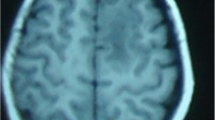Summary
MR imaging was performed on 27 children with stage II–III tuberculous meningitis for the specific purpose of examining the brainstem, as well as comparison with other CT features of the disease. In addition to defining the ischemic disturbances of basal ganglia and diencephalon more clearly, MR also demonstrates the frequent occurrence of parenchymal signal abnormalities in the brainstem and adjacent temporal lobes, which are invisible or uncertain on CT. Although the presence of brainstem abnormalities on MR correlated well with clinical findings of brainstem dysfunction, clinical staging on admission remains the best prognostic indicator in advanced TBM. We also review the MR features of basal exudation, hydrochephalus and tuberculoma.
Similar content being viewed by others
References
Bateman DE, Newman PK, Foster JB (1983) A retrospective survey of proven cases of tuberculous meningitis in the northern region, 1970–1980. J R Coll Physicians Lond 17:106–110
Bullock MRR, Van Dellen JR (1982) The role of cerebrospinal shunting in tuberculous meningitis. Surg Neurol 18: 274–277
Schoeman JF (1987) The role of intracranial pressure monitoring in the management of children with tuberculous meningitis. MD Thesis, University of Stellenbosch, Cape Town
Medical Research Council (1948) Streptomycin treatment of tuberculous meningitis. Lancet I:582–596
Schoeman JF, Le Roux D, Bezuidenhout PB, Donald PR (1985) Intracranial pressure monitoring in tuberculous meningitis: clinical and CT correlation. Dev Med Child Neurol 27:644–654
Dastur DK, Lalitha VS (1973) The many facets of neurotuberculosis: an epitome of neuropathology. In: Zimmerman HM (ed) Progress in neuropathology. Grune & Stratton, New York, pp 351–408
Trautmann M, Kluge W, Otto H, Loddenkemper R (1986) Computed tomography in CNS tuberculosis. Eur Neurol 25: 91–97, 341–344
Bullock MRR, Welchman JM (1982) Diagnostic and prognostic features of tuberculous meningitis on CT scanning. J Neurol Neurosurg Psychiatry 45:1098–1101
Artopoulos J, Chalemis Z, Christopoulos S, Manios S, Kalekis L (1984) Sequential computed tomography in tuberculous meningitis in infants and children. Comput Radiol 8: 271–277
Bhargava S, Gupta AK, Tandon PN (1982) Tuberculous meningitis — a CT study. Br J Radiol 4:189–196
Schroth G, Kretzschmar K, Gawehn J, Voigt K (1987) Advantage of magnetic resonance imaging in the diagnosis of cerebral infections. Neuroradiology 29:120–126
Author information
Authors and Affiliations
Rights and permissions
About this article
Cite this article
Schoeman, J., Hewlett, R. & Donald, P. MR of childhood tuberculous meningitis. Neuroradiology 30, 473–477 (1988). https://doi.org/10.1007/BF00339685
Received:
Issue Date:
DOI: https://doi.org/10.1007/BF00339685




